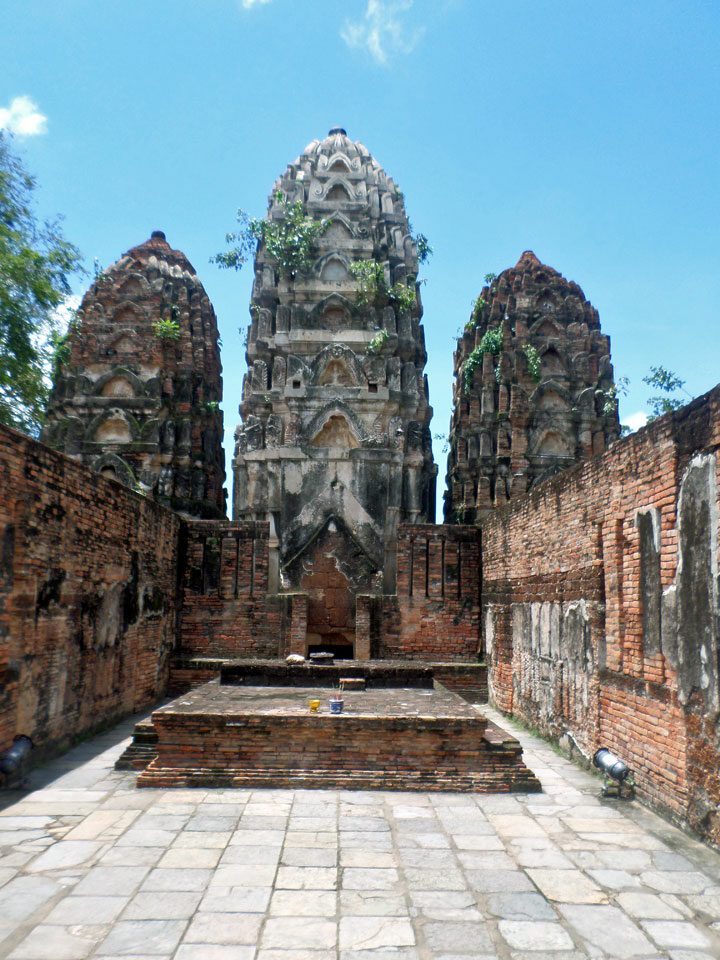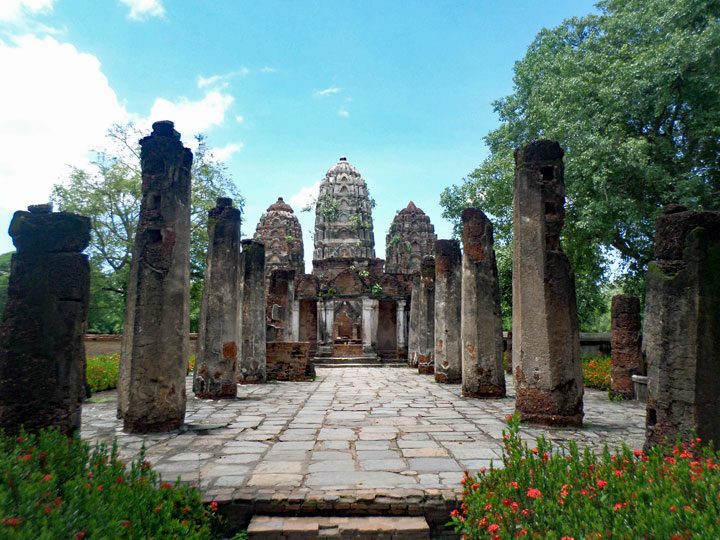Wat Si Sawai: impeccable Khmer architecture

Wat Si Sawai
Whenever I come near Sukhothai Historical Park, I cannot fail to visit Wat Si Sawai, in my opinion one of the most accomplished achievements of the Khmer architects, almost a thousand years ago.
I still remember as if it were yesterday how when I first visited this temple, more than twenty years ago, I was blown away by the sublime, peerless aesthetic of this shrine. A feeling that invariably creeps up on me, again and again, with every visit. This temple complex is somewhat isolated, in the shade of the trees, on the edge of the Historical Park, a few hundred meters southwest of Wat Mahathat at the Namo Gate.
Historians and archaeologists believe that Wat Si Sawai is one of the oldest temples in Sukhothai. It is said to have been built under the reign of the powerful Khmer king Jayavarman VII (1181-1219) towards the end of the twelfth or the beginning of the thirteenth century, before Sukhothai became the capital of the kingdom. Despite the fact that Jayavarman VII was a devout Buddhist, this temple appears to have been Hindu in origin.
Numerous finds, such as a linga stone, a yoni (which can be found on the outside of the eastern prang) and a capstone with a bas-relief depicting the Hindu creation myth, point in this direction. Many of these finds and artifacts now belong to the permanent collection of the Ramkhamhaeng National Museum in Sukhothai. The name of the temple would also refer to Hinduism. No one has the slightest idea what this complex was called in the Khmer period, but the highly influential Prince Damrong Rajanubhab (1862-1943), a self-proclaimed historian who was the half-brother of King Chulalongkorn, developed the theory that the current name of Wat Si Sawai might be are derived from Sri Siwaya (ศรีศิวายะ) which in Pali 'Glorious Shiva' would mean. A very plausible explanation because in 1907 Chulalongkorn found a Shiva statue when visiting this site. The excavations that took place during this visit also brought to light two massive logs. A find that tempted the Siamese king to formulate the theory that they were used for the Brahamanistic Triyampavai - Tripavai ceremony, the New Year's ritual with the giant swing.
Iconic in Wat Si Sawai are the three breathtakingly beautiful and in excellent condition flask-shaped prangs or towers richly decorated with garudas, Kala faces and naga, which, unlike most other Khmer shrines, were not built on the east, but on the south. oriented. The central tower is almost 15 m high, the other two are about three meters lower. All three were never finished by the Khmer. After all, the bases were built in laterite, as was the custom of the Khmer, but the upper half consists of brick, which indicates that the Siamese have finished them. This probably only happened in the fifteenth century when the Siamese center of power had already shifted from Sukhothai to Ayutthaya. The prangs were then covered with white stucco and finished in a style that, despite the clear influence of the Khmer Bayon style, is very reminiscent of the prangs in Lopburi.
What we know for sure to be from the Sukhothai era are the later additions, and more specifically the two, nearly 20 m long Wihan, prayer halls or halls at the front of the temple complex. They date from the fourteenth century when this temple was converted into a Buddhist shrine and a Buddhist monastery was established in and near this temple. The large, laterite columns are about all that remains of the southern Wihan. But they are good for the most photogenic see-through shot of the prangs…

Bodi tree
A brick wall of 36 by 30 m encloses the inner part of this complex. On the southeastern side of this inner enclosure is a photogenic and above all imposing Bodi tree with powerful roots extending in all directions. A more than man-sized outer wall of 110 by 100 m in large blocks of laterite surrounds the temple grounds. The whole complex was once surrounded by a wide moat as a symbolic boundary for the Hindu universe, but only a part of it remains at the rear, known to the locals as Sa Loi Bab,'the pond for the floating sins'…
The age of this temple, its unique features and unusual location are just as many reasons to make some time to visit this shrine. You certainly won't regret it. Oh yes, as a conclusion: Sometimes the name of this temple is also spelled Wat Sri Savaya. There is nothing wrong with that, but it is incomprehensible that this temple has been incorrectly referred to as Wat Si Sawat on the tickets that are handed out to visitors when entering the Sukhothai Historical Park for years…



Hi, We have been there too, very impressive and there is a certain one
atmosphere, I can't name it!
Dear Lung Jan,
What is the middle tower for.
Can a monk enter there?
Were relics put in there in the distant past.
Were ceremonies held in front of the tower?
Just some questions that occurred to me.
Regards,
Louis L.
Dear Louis,
No, no relics were hidden in the towers. You can descend into the middle tower (ground level is about 40 cm lower than the front, which may have to do with the height of the terrace of the later built Wihan). It is certain that the inside of the tower was used for Hindu- ceremonies, possibly fertility rituals, given the yoni and linga stones found at this temple. Today, however, the tower is completely empty except for a few snakes and the remains of what may have been a ceiling from the 15th - 16th century... In front of the towers there were two Wihan or prayer and meeting halls that are of later date and therefore Buddhist goods.
The Khmer Empire extended beyond Sukhothai, Sakon Nakhorn, Lopburi and Pechaburi.
At the end of the 12th - beginning of the 13th century, the Thais came from the north and gradually conquered this entire area, which was then called Siam / Tahiland.
What happened to the original population? Were they also Khmer, did they flee or were they murdered? The Thais were probably only the rulers over the existing local non-Thai population and everyone became far-Thai in the course of the following centuries. Thai means 'free' and the rulers were free. Not their subjects: serfs and slaves.
Too bad we know so little about it.
Nice piece by Lung Jan. 1.5 Km north of Wat Si Sawai is another ancient Khmer site surrounded by a 600m-long moat, today called Wat Phra Phai Luang. Traces of the large water reservoir or 'baray' that belonged to this complex can still be found to the east of this site. There is another Khmer shrine 900 m south of Wat Phra Phai Luang (approximately the same distance north of Wat Si Sawai and almost on the same axis) called Ta Pha Daeng. It was initially thought that the shrine dates from the period of Suriyavarman II (1113-1150 CE), but this was later revised to the late 12th/early 13th century and, like Wat Phra Phai Luang, belongs to the period of Jayavarman VII (1180-1219). CE). It can be assumed that there used to be more Khmer structures, but they disappeared with the ravages of time or were simply built over by Thai temples. The Khmer structures in Sukhothai are associated with Lavo (Lop Buri). Finally, I can complement Tino; even in Nong Khai there are still remains of a Khmer settlement, namely Wiang Khuk.